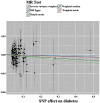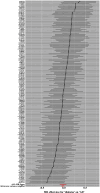Causal Association Between Type 2 Diabetes Mellitus and Alzheimer's Disease: A Two-Sample Mendelian Randomization Study
- PMID: 39114544
- PMCID: PMC11305840
- DOI: 10.3233/ADR-240053
Causal Association Between Type 2 Diabetes Mellitus and Alzheimer's Disease: A Two-Sample Mendelian Randomization Study
Abstract
Background: There is now increasing evidence that type 2 diabetes mellitus (T2DM) is associated with Alzheimer's disease (AD). However, it is unclear whether the two are causally related.
Objective: To reveal the causal association between T2DM and AD, we performed a bidirectional Mendelian randomization (MR) analysis.
Methods: Genetic instrumental variables were systematically screened, and inverse-variance weighting, MR-Egger regression, weighted median, simple mode, and weighted mode were applied to assess the pathogenic associations between the two diseases, and sensitivity analyses were used to further validate the robustness of the results.
Results: The results of forward MR analysis with T2DM as the exposure were [OR = 0.998, 95% CI (0.975∼1.021), p = 0.857], and the results of reverse MR analysis with AD as the exposure were [OR = 0.966, 95% CI (0.934∼0.999), p = 0.043]. The results showed no significant association between T2DM and AD at the gene level (p < 0.025). Sensitivity analyses were consistent with the results of the main analysis, confirming the robustness of the study.
Conclusions: T2DM and AD may not be genetically causally associated.
Keywords: Alzheimer’s disease; Mendelian randomization; causal association; type 2 diabetes mellitus.
© 2024 – The authors. Published by IOS Press.
Conflict of interest statement
The authors have no conflict of interest to report.
Figures







Similar articles
-
Appendicular lean mass and the risk of stroke and Alzheimer's disease: a mendelian randomization study.BMC Geriatr. 2024 May 18;24(1):438. doi: 10.1186/s12877-024-05039-5. BMC Geriatr. 2024. PMID: 38762444 Free PMC article.
-
Causal relationship between Alzheimer's disease and prostate cancer: a bidirectional Mendelian randomization analysis.Front Endocrinol (Lausanne). 2024 Mar 13;15:1354528. doi: 10.3389/fendo.2024.1354528. eCollection 2024. Front Endocrinol (Lausanne). 2024. PMID: 38544686 Free PMC article.
-
Causal linkage between type 2 diabetes mellitus and inflammatory bowel disease: an integrated Mendelian randomization study and bioinformatics analysis.Front Endocrinol (Lausanne). 2024 Jan 19;15:1275699. doi: 10.3389/fendo.2024.1275699. eCollection 2024. Front Endocrinol (Lausanne). 2024. PMID: 38313367 Free PMC article.
-
Causal relationships between delirium and Alzheimer's disease: a bidirectional two-sample Mendelian randomization study.Eur J Med Res. 2023 Aug 7;28(1):271. doi: 10.1186/s40001-023-01245-w. Eur J Med Res. 2023. PMID: 37550780 Free PMC article.
-
Evaluating the Causal Association Between Type 2 Diabetes and Alzheimer's Disease: A Two-Sample Mendelian Randomization Study.Biomedicines. 2025 Apr 30;13(5):1095. doi: 10.3390/biomedicines13051095. Biomedicines. 2025. PMID: 40426922 Free PMC article. Review.
Cited by
-
GLP-1R as a potential link between diabetes and Alzheimer's disease.Front Aging Neurosci. 2025 Jul 24;17:1601602. doi: 10.3389/fnagi.2025.1601602. eCollection 2025. Front Aging Neurosci. 2025. PMID: 40778306 Free PMC article. Review.
-
Impact of diabetes mellitus on the risk of Alzheimer's disease: a mendelian randomization study.BMC Neurol. 2024 Nov 18;24(1):448. doi: 10.1186/s12883-024-03955-y. BMC Neurol. 2024. PMID: 39558225 Free PMC article.
References
LinkOut - more resources
Full Text Sources

